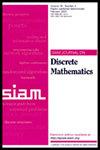Partial Reflections and Globally Linked Pairs in Rigid Graphs
IF 1
3区 数学
Q2 MATHEMATICS
引用次数: 0
Abstract
SIAM Journal on Discrete Mathematics, Volume 38, Issue 3, Page 2005-2040, September 2024.Abstract. A [math]-dimensional framework is a pair [math], where [math] is a graph and [math] maps the vertices of [math] to points in [math]. The edges of [math] are mapped to the corresponding line segments. A graph [math] is said to be globally rigid in [math] if every generic [math]-dimensional framework [math] is determined, up to congruence, by its edge lengths. A finer property is global linkedness: we say that a vertex pair [math] of [math] is globally linked in [math] in [math] if in every generic [math]-dimensional framework [math] the distance between [math] and [math] is uniquely determined by the edge lengths. In this paper we investigate globally linked pairs in graphs in [math]. We give several characterizations of those rigid graphs [math] in which a pair [math] is globally linked if and only if there exist [math] internally disjoint paths from [math] to [math] in [math]. We call these graphs [math]-joined. Among others, we show that [math] is [math]-joined if and only if for each pair of generic frameworks of [math] with the same edge lengths, one can be obtained from the other by a sequence of partial reflections along hyperplanes determined by [math]-separators of [math]. We also show that the family of [math]-joined graphs is closed under edge addition, as well as under gluing along [math] or more vertices. As a key ingredient to our main results, we prove that rigid graphs in [math] contain no crossing [math]-separators. Our results give rise to new families of graphs for which global linkedness (and global rigidity) in [math] can be tested in polynomial time.
刚性图中的局部反射和全局关联对
SIAM 离散数学杂志》,第 38 卷第 3 期,第 2005-2040 页,2024 年 9 月。 摘要一个[math]维框架是一对[math],其中[math]是一个图,[math]将[math]的顶点映射到[math]中的点。数学]的边映射为相应的线段。如果一个图[math]的每一个通用[math]维框架[math]都是由它的边长决定的(直到全等),那么这个图[math]在[math]中就被称为全局刚性图。一个更精细的属性是全局链接性:如果在每一个通用的[math]维框架[math]中,[math]和[math]之间的距离是由边长唯一决定的,我们就说[math]的一对顶点[math]在[math]中是全局链接的。在本文中,我们研究了[math]中图的全局链接对。我们给出了刚性图[math]的几个特征,在这些刚性图[math]中,当且仅当[math]中存在从[math]到[math]的[math]内部不相交路径时,一对[math]是全局相连的。我们称这些图为[math]连接图。其中,我们证明了当且仅当[math]的每一对具有相同边长的一般框架可以通过沿由[math]的[math]分隔符决定的超平面的部分反射序列从另一个框架得到时,[math]是[math]连接的。我们还证明,[math]连接图系在边相加以及沿[math]或更多顶点胶合的情况下是封闭的。作为主要结果的关键要素,我们证明了[math]中的刚性图不包含交叉[math]分隔符。我们的结果产生了新的图族,对于这些图族,[math] 中的全局链接性(和全局刚性)可以在多项式时间内得到检验。
本文章由计算机程序翻译,如有差异,请以英文原文为准。
求助全文
约1分钟内获得全文
求助全文
来源期刊
CiteScore
1.90
自引率
0.00%
发文量
124
审稿时长
4-8 weeks
期刊介绍:
SIAM Journal on Discrete Mathematics (SIDMA) publishes research papers of exceptional quality in pure and applied discrete mathematics, broadly interpreted. The journal''s focus is primarily theoretical rather than empirical, but the editors welcome papers that evolve from or have potential application to real-world problems. Submissions must be clearly written and make a significant contribution.
Topics include but are not limited to:
properties of and extremal problems for discrete structures
combinatorial optimization, including approximation algorithms
algebraic and enumerative combinatorics
coding and information theory
additive, analytic combinatorics and number theory
combinatorial matrix theory and spectral graph theory
design and analysis of algorithms for discrete structures
discrete problems in computational complexity
discrete and computational geometry
discrete methods in computational biology, and bioinformatics
probabilistic methods and randomized algorithms.

 求助内容:
求助内容: 应助结果提醒方式:
应助结果提醒方式:


